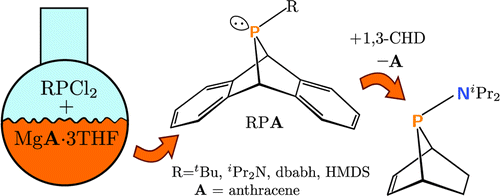当前位置:
X-MOL 学术
›
J. Am. Chem. Soc.
›
论文详情
Our official English website, www.x-mol.net, welcomes your
feedback! (Note: you will need to create a separate account there.)
Facile Synthesis of Dibenzo-7λ3-phosphanorbornadiene Derivatives Using Magnesium Anthracene
Journal of the American Chemical Society ( IF 14.4 ) Pub Date : 2012-08-20 , DOI: 10.1021/ja306902j
Alexandra Velian 1 , Christopher C. Cummins 1
Journal of the American Chemical Society ( IF 14.4 ) Pub Date : 2012-08-20 , DOI: 10.1021/ja306902j
Alexandra Velian 1 , Christopher C. Cummins 1
Affiliation

|
Unprotected dibenzo-7λ(3)-phosphanorbornadiene derivatives RPA (A = C(14)H(10) or anthracene; R = (t)Bu, dbabh = NA, HMDS = (Me(3)Si)(2)N, (i)Pr(2)N) are synthesized by treatment of the corresponding phosphorus dichloride RPCl(2) with MgA·3THF, in cold THF (~20% to 30% isolated yields). Anthracene and the corresponding cyclic phosphane (RP)(n) form as coproducts. Characteristic NMR features of the RPA derivatives include a doublet near 4 ppm in their (1)H NMR spectra and a triplet peak in the 175-212 ppm region of the (31)P NMR spectrum ((2)J(PH) ~14 Hz). The X-ray structures of the AN-PA and (HMDS)PA derivatives are discussed. Thermolysis of RPA benzene-d(6) solutions leads to anthracene extrusion. This process has a unimolecular kinetic profile for the (i)Pr(2)NPA derivative. The 7-phosphanorbornene anti-(i)Pr(2)NP(C(6)H(8)) could be synthesized (70% isolated yield) by thermolysis of (i)Pr(2)NPA in 1,3-cyclohexadiene.
中文翻译:

使用蒽镁简便合成二苯并 7λ3-磷化冰片二烯衍生物
未保护的二苯并-7λ(3)-膦降冰片二烯衍生物 RPA(A = C(14)H(10) 或蒽;R = (t)Bu, dbabh = NA, HMDS = (Me(3)Si)(2)N, (i)Pr(2)N) 是通过在冷 THF 中用 MgA·3THF 处理相应的二氯化磷 RPCl(2) 合成的(约 20% 至 30% 的分离产率)。蒽和相应的环状磷烷 (RP)(n) 作为副产物形成。RPA 衍生物的特征 NMR 特征包括其 (1)H NMR 光谱中接近 4 ppm 的双峰和 (31)P NMR 光谱 ((2)J(PH) ~14 的 175-212 ppm 区域中的三重峰赫兹)。讨论了 AN-PA 和 (HMDS)PA 衍生物的 X 射线结构。RPA 苯-d(6) 溶液的热解导致蒽挤出。该过程具有 (i)Pr(2)NPA 衍生物的单分子动力学曲线。
更新日期:2012-08-20
中文翻译:

使用蒽镁简便合成二苯并 7λ3-磷化冰片二烯衍生物
未保护的二苯并-7λ(3)-膦降冰片二烯衍生物 RPA(A = C(14)H(10) 或蒽;R = (t)Bu, dbabh = NA, HMDS = (Me(3)Si)(2)N, (i)Pr(2)N) 是通过在冷 THF 中用 MgA·3THF 处理相应的二氯化磷 RPCl(2) 合成的(约 20% 至 30% 的分离产率)。蒽和相应的环状磷烷 (RP)(n) 作为副产物形成。RPA 衍生物的特征 NMR 特征包括其 (1)H NMR 光谱中接近 4 ppm 的双峰和 (31)P NMR 光谱 ((2)J(PH) ~14 的 175-212 ppm 区域中的三重峰赫兹)。讨论了 AN-PA 和 (HMDS)PA 衍生物的 X 射线结构。RPA 苯-d(6) 溶液的热解导致蒽挤出。该过程具有 (i)Pr(2)NPA 衍生物的单分子动力学曲线。































 京公网安备 11010802027423号
京公网安备 11010802027423号